Illinois boasts a diverse avian population, with its skies graced by the majestic presence of 10 distinct hawk species.
These raptors, ranging from the agile Sharp-shinned Hawk to the formidable Northern Goshawk, contribute to the state’s ecological balance and offer a captivating glimpse into the wonders of nature.
Each hawk species has its unique characteristics, habitats, and roles within Illinois’ ecosystems.
Here, we unveil the identities of these 10 remarkable hawk species, shedding light on their habitats and the vital roles they play in maintaining the intricate web of life in the Illinois landscape.
Join us on a journey through the skies as we unravel the stories of these awe-inspiring Hawks of Illinois. Stay focused.
10 Hawks of Illinois
Exploring the diverse avian residents of Illinois, a rich tapestry of hawks graces its skies. Each species contributes to the ecological balance, from the agile Sharp-shinned Hawk to the majestic Ferruginous Hawk.
Delve into the fascinating lives of these raptors, from their habitats to hunting styles, as we unveil the marvels of Illinois’ hawk population.
1. Sharp-shinned Hawk

- Scientific name: Accipiter striatus
- Population: The population of Sharp-shinned Hawks is not precisely known, but they are considered fairly common.
- Life span: Typically, sharp-skinned hawks live up to 10 years in the wild.
- Size: They measure around 10 to 14 inches in length.
- Weight: Sharp-shinned Hawks generally weigh between 3 to 8 ounces.
- Food: Their diet primarily consists of small birds, often caught in flight.
- Wingspan: They have a wingspan of about 17 to 22 inches.
- Status: Sharp-shinned Hawks are classified as least concern in terms of conservation status.
The Sharp-shinned Hawk is an agile and skilled predator known for its swift flight. It prefers dense woodlands where it can use its maneuverability to navigate through trees while hunting.
Their diet mainly consists of smaller birds like sparrows and finches, which they catch by surprise with sudden bursts of speed.
Sharp-shinned Hawks are migratory, with many individuals spending winters in the southern United States or even farther south. They are adaptable birds, often seen in urban areas with ample prey and suitable perching locations.
2. Cooper’s Hawk

- Scientific name: Accipiter cooperii
- Population: Cooper’s Hawks are relatively common and have stable populations.
- Life span: They typically live up to 12 years in the wild.
- Size: Cooper’s Hawks have a length ranging from 14 to 20 inches.
- Weight: Their weight varies between 7 to 24 ounces.
- Food: They primarily prey on birds, especially pigeons and doves.
- Wingspan: They have a wingspan of about 24 to 35 inches.
- Status: Cooper’s Hawks are also categorized as least concern.
Cooper’s Hawks are well-adapted hunters, utilizing their agility and speed to navigate through dense vegetation in pursuit of prey.
Their diet mainly consists of medium-sized birds, and they are known for their ability to surprise their prey with sudden, powerful flights.
These hawks can be found in various habitats, including woodlands, suburban areas, and even city parks. Cooper’s Hawks are territorial during the breeding season and are known for their impressive courtship displays.
3. Broad-winged Hawk
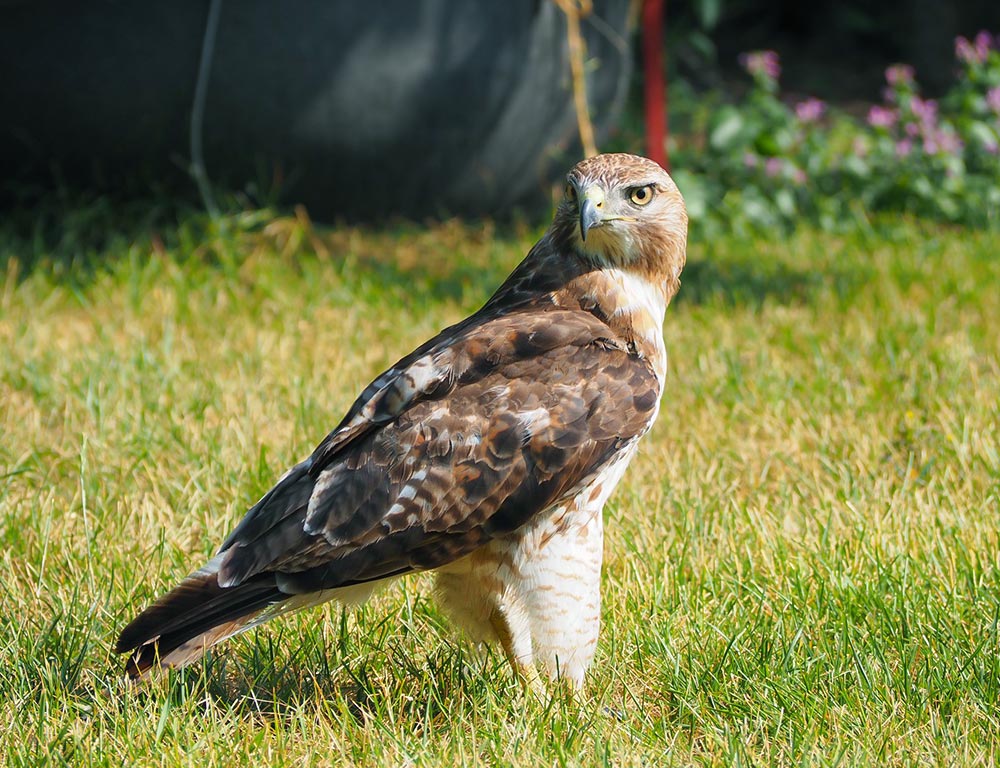
- Scientific name: Buteo platypterus
- Population: Broad-winged Hawks have fluctuating populations, with variations in prey availability.
- Life span: In the wild, they generally live up to 6-10 years.
- Size: They have a length ranging from 13 to 17 inches.
- Weight: Broad-winged Hawks weigh around 9 to 20 ounces.
- Food: Their diet primarily consists of small mammals, reptiles, and amphibians.
- Wingspan: They have a wingspan of about 32 to 39 inches.
- Status: Broad-winged Hawks are also classified as least concern.
Broad-winged Hawks are known for their migratory behavior and often form large flocks during migration. They prefer wooded areas and are commonly found in forests with open understories.
Their diet is diverse, including small mammals like mice and amphibians. These hawks are recognized for their distinctive high-pitched calls during migration.
Broad-winged Hawks play a crucial role in controlling populations of small mammals and contribute to the overall balance of ecosystems in the regions they inhabit.
4. Red-tailed Hawk

- Scientific name: Buteo jamaicensis
- Population: Red-tailed Hawks are widespread and have stable populations.
- Life span: In the wild, they can live up to 10-15 years.
- Size: They have a length ranging from 18 to 26 inches.
- Weight: Red-tailed Hawks typically weigh between 2 to 4 pounds.
- Food: Their diet consists mainly of rodents, rabbits, and small mammals.
- Wingspan: They have a wingspan of about 43 to 56 inches.
- Status: Red-tailed Hawks are the least concerned in terms of conservation status.
Red-tailed Hawks are adaptable birds found in various habitats, from deserts to forests. They are often seen soaring high in the sky, searching for prey. Their keen eyesight helps them spot small mammals from great distances.
Red-tailed Hawks are territorial during the breeding season and build large nests on high vantage points like trees or cliffs. They are powerful fliers, using thermal updrafts to soar effortlessly.
Their iconic “red” tail is more of a brick-red or rusty color, and they are known for their distinct, raspy scream.
5. Swainson’s Hawk
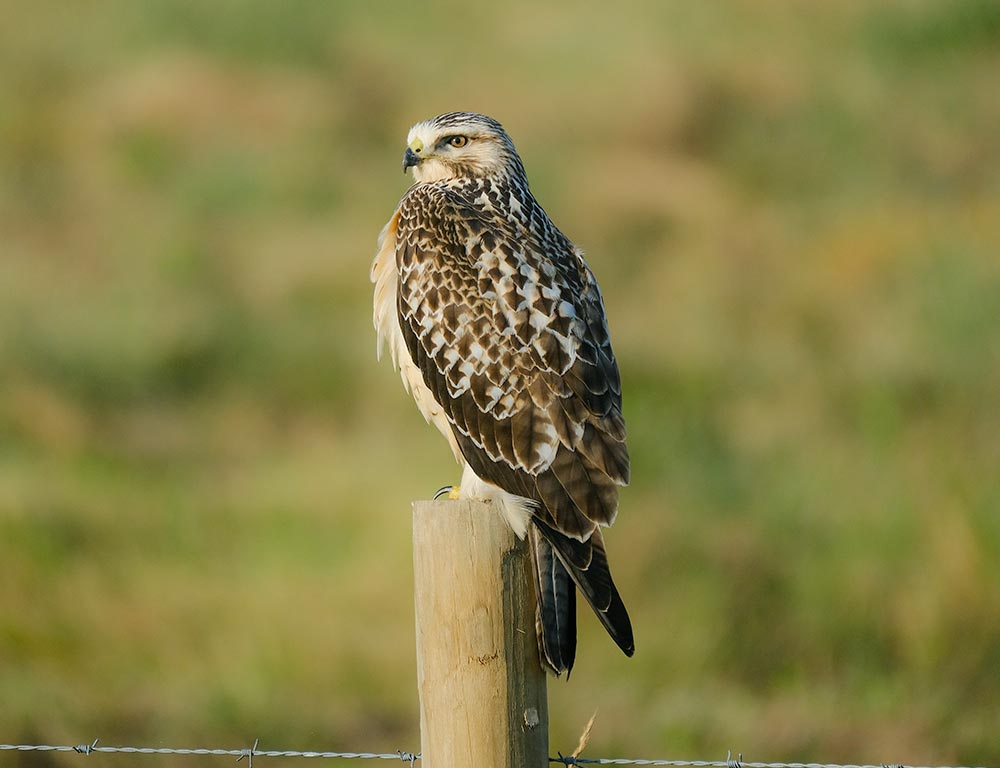
- Scientific name: Buteo swainsoni
- Population: Swainson’s Hawks have a relatively stable population.
- Life span: In the wild, they can live up to 10-15 years.
- Size: They measure around 18 to 22 inches in length.
- Weight: Swainson’s Hawks typically weigh between 2 to 3 pounds.
- Food: Their diet consists mainly of large insects and small mammals.
- Wingspan: They have a wingspan of about 45 to 54 inches.
- Status: Swainson’s Hawks are categorized as least concern.
Swainson’s Hawks are migratory birds, covering vast distances during their annual migrations between North and South America. They are often seen in large flocks, especially during migration.
Their preferred habitats include open grasslands and prairies. They feed primarily on insects during the breeding season, making them beneficial for pest control. Swainson’s Hawks build nests in trees and are known for their characteristic soaring flight.
6. Rough-legged Hawk
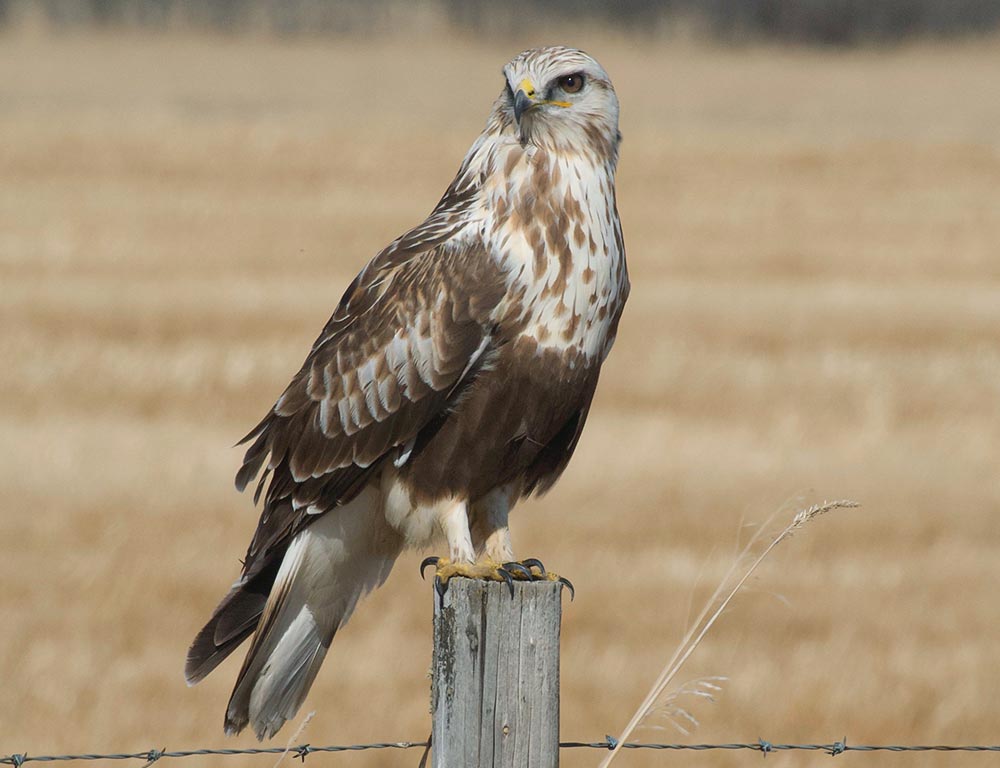
- Scientific name: Buteo lagopus
- Population: Rough-legged Hawks have populations that can vary, with changes in prey availability.
- Life span: They generally live up to 5-10 years in the wild.
- Size: They measure around 18 to 24 inches in length.
- Weight: Rough-legged Hawks typically weigh between 2 to 3 pounds.
- Food: Their diet consists mainly of small mammals, especially voles and lemmings.
- Wingspan: They have a wingspan of about 52 to 54 inches.
- Status: Rough-legged Hawks are categorized as least concern.
Rough-legged Hawks are adapted to life in the Arctic tundra and boreal forests during the breeding season. They are known for their distinctive feathered legs extending down to their feet, providing insulation against the cold.
During the winter, they migrate to more southern regions. Rough-legged Hawks often hover over fields, scanning for prey. Their diet mainly consists of small mammals, and they are efficient hunters, capable of hovering in the air for extended periods.
7. Northern Goshawk
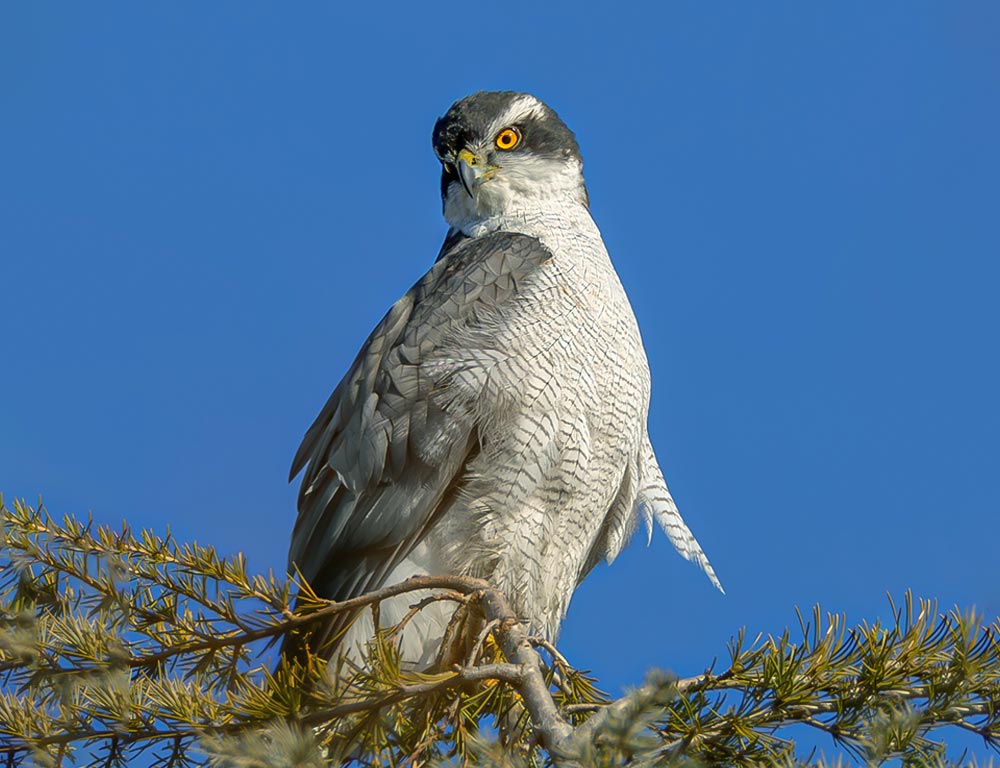
- Scientific name: Accipiter gentilis
- Population: Northern Goshawks have populations that can vary, influenced by habitat availability.
- Life span: In the wild, they can live up to 8-16 years.
- Size: They have a length ranging from 20 to 26 inches.
- Weight: Northern Goshawks typically weigh between 1.5 to 3.5 pounds.
- Food: Their diet consists of birds and mammals, including larger prey like hares and grouse.
- Wingspan: They have a wingspan of about 40 to 46 inches.
- Status: Northern Goshawks are categorized as the least concerned.
Northern Goshawks are powerful and secretive raptors that inhabit mature forests. They are known for their agility and intelligence in hunting, often maneuvering through dense vegetation to catch prey by surprise.
Their diet is diverse, including birds and mammals. Northern Goshawks are territorial during the breeding season and construct nests in large trees.
They are well-adapted to forested environments, using their strong flight capabilities to navigate through the trees while hunting.
8. Red-shouldered Hawk
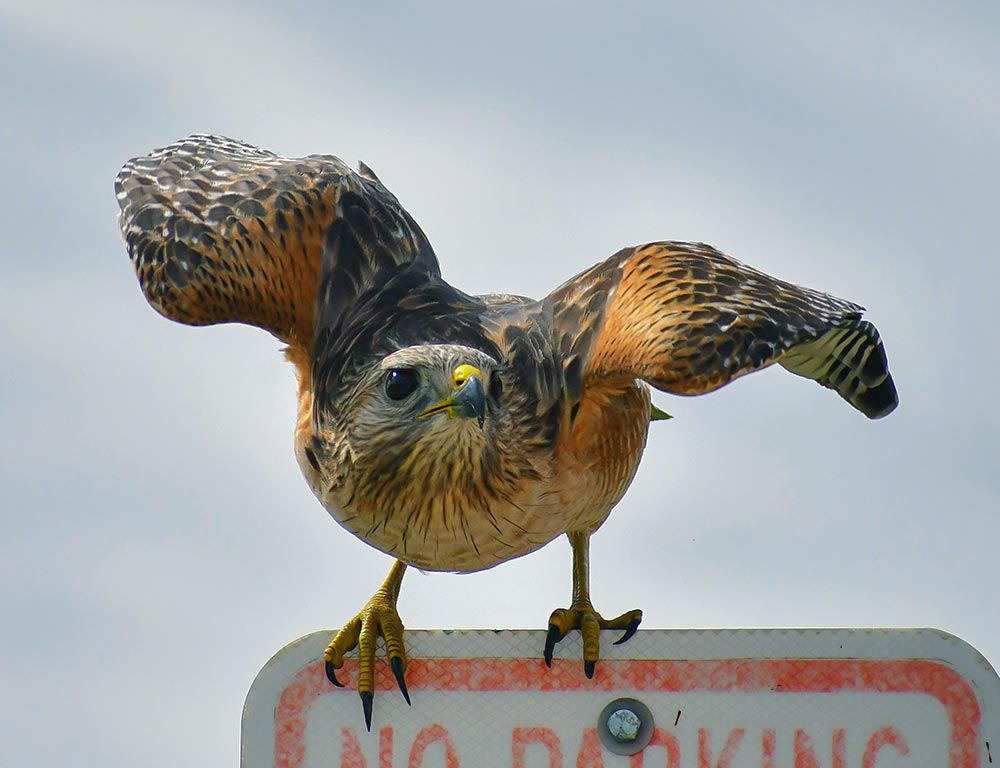
- Scientific name: Buteo lineatus
- Population: Red-shouldered Hawks have stable populations.
- Life span: In the wild, they can live up to 10-15 years.
- Size: They measure around 16 to 24 inches in length.
- Weight: Red-shouldered Hawks typically weigh between 1 to 2 pounds.
- Food: Their diet consists mainly of small mammals, amphibians, and reptiles.
- Wingspan: They have a wingspan of about 37 to 43 inches.
- Status: Red-shouldered Hawks are categorized as least concern.
Red-shouldered Hawks are often found in deciduous and mixed woodlands, nesting and foraging. They are known for their distinctive loud calls, especially during the breeding season.
Their diet includes small mammals, reptiles, and amphibians, and they are skilled hunters who can capture prey on the ground or in mid-air.
Red-shouldered Hawks are territorial birds, and they build nests in the forks of large trees. Their flight is characterized by deep, deliberate wing beats.
9. Northern Harrier
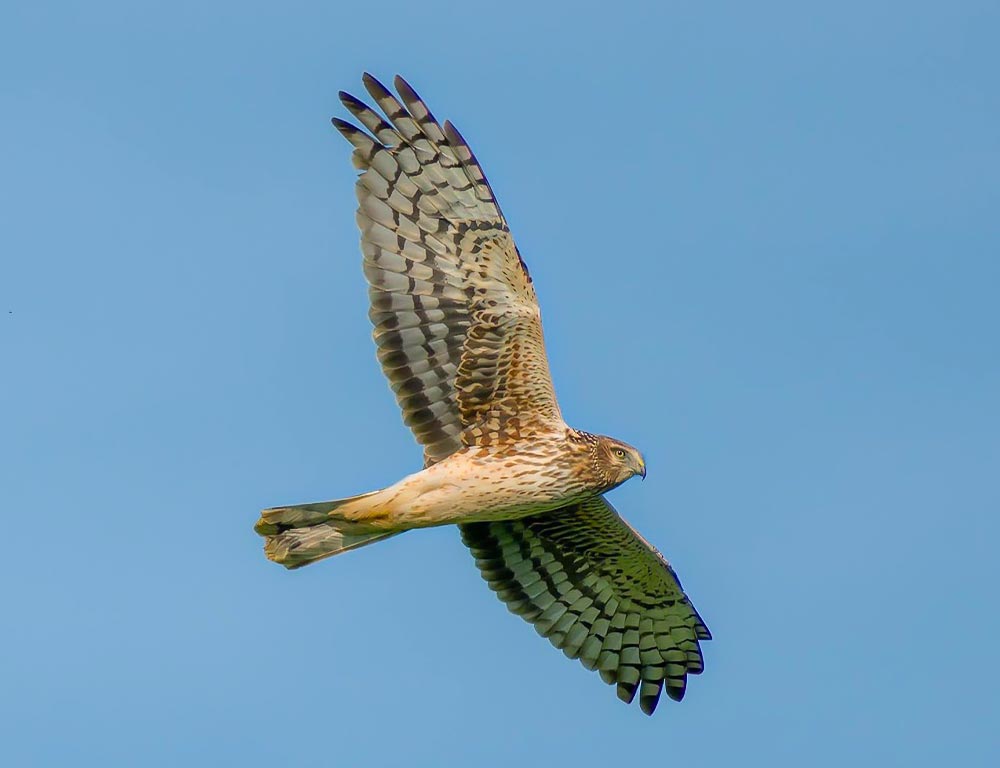
- Scientific name: Circus hudsonius
- Population: Northern Harriers have populations that can vary, influenced by habitat availability.
- Life span: In the wild, they generally live up to 5-10 years.
- Size: They measure around 18 to 24 inches in length.
- Weight: Northern Harriers typically weigh between 10 to 26 ounces.
- Food: Their diet consists mainly of small mammals and birds.
- Wingspan: They have a wingspan of about 38 to 48 inches.
- Status: Northern Harriers are categorized as least concern.
Northern Harriers are birds of prey that prefer open habitats, including marshes, grasslands, and agricultural fields. They have a distinctive hunting style, gliding low over the ground with their wings held in a V-shape, searching for prey.
Their diet includes small mammals, birds, and sometimes even insects. Northern Harriers are known for their owl-like facial disk, which helps them precisely locate and capture prey. They build their nests on the ground in tall grasses or reeds.
10. Ferruginous Hawk

- Scientific name: Buteo regalis
- Population: Ferruginous Hawks have populations that can vary, with changes in prey availability.
- Life span: They generally live up to 8-12 years in the wild.
- Size: They have a length ranging from 22 to 29 inches.
- Weight: Ferruginous Hawks typically weigh between 2.5 to 5.5 pounds.
- Food: Their diet consists mainly of ground squirrels, prairie dogs, and other small mammals.
- Wingspan: They have a wingspan of about 45 to 60 inches.
- Status: Ferruginous Hawks are categorized as least concern.
Ferruginous Hawks are birds of open grasslands and deserts, often found in arid environments. They are known for their striking light coloration, especially on their underparts and legs.
Their diet primarily consists of ground-dwelling mammals, and they are skilled hunters who use their powerful talons to capture prey. Ferruginous Hawks build large nests on cliffs or trees, and they are known for their soaring flight.
During the breeding season, they engage in courtship displays that involve aerial acrobatics.
How to Preserve Hawks in Illinois?
Preserving the hawk population in Illinois is crucial for maintaining ecological balance and biodiversity. Here are some elaborate strategies to ensure the well-being and conservation of these majestic birds of prey:
Habitat Preservation
Establishing and safeguarding designated habitats is pivotal for hawk preservation. This involves identifying and protecting diverse landscapes that cater to the distinct needs of various hawk species.
Whether it’s wooded areas for perching or open grasslands for hunting, creating and maintaining these habitats ensures hawks have the necessary resources for nesting, foraging, and breeding.
Reducing Pesticide Use
Advocacy for policies minimizing pesticide use is critical in safeguarding hawk populations. Pesticides, particularly those used in agriculture, can contaminate the prey species of hawks, leading to potential toxicity and even death.
Reducing pesticide use protects prey and mitigates the risk of secondary poisoning in hawks, who may ingest contaminated prey.
Community Education Programs
Developing comprehensive educational initiatives is vital in garnering community support for hawk conservation.
These programs should focus on raising awareness about the ecological importance of hawks, their unique roles in maintaining balanced ecosystems, and practical ways individuals and communities can actively contribute to their conservation efforts.
Raptor Rehabilitation Centers
Supporting and funding rehabilitation centers is crucial for the well-being of injured hawks.
These centers provide specialized medical care and rehabilitation and, when possible, release injured or sick hawks back into their natural habitats.
By facilitating the recovery of these birds, rehabilitation centers contribute significantly to maintaining and bolstering hawk populations.
Monitoring and Research
Conducting extensive research and monitoring programs is essential for understanding the dynamics of hawk populations. This includes studying migration patterns, identifying key habitats, and monitoring potential threats.
Informed by robust data, conservation strategies can be tailored to address specific challenges, ensuring the long-term viability of hawk species.
Legal Protections
Advocating for and strengthening legal protections is crucial to combatting threats to hawk populations.
This involves enacting and enforcing laws against poaching and implementing regulations to curtail illegal hunting, trade, and habitat destruction.
A robust legal framework is indispensable for preserving hawks and their ecosystems.
Collaborative Conservation Efforts
Fostering collaboration among various stakeholders is essential for a holistic approach to hawk conservation.
Government agencies, environmental organizations, and the public must share resources, expertise, and responsibilities.
Collaborative efforts enable the development of comprehensive conservation strategies, ensuring a unified and effective front in safeguarding hawk populations and their habitats.
Wrapping Up
In the realm of preserving the majestic Hawks of Illinois, a multi-faceted approach emerges as the key to ensuring their continued existence.
We forge a path toward harmony between these raptors and their environments through habitat preservation, reduced pesticide use, community education, and collaborative efforts.
Supporting rehabilitation centers and strengthening legal protections further fortify our commitment to their well-being.
The fusion of research insights and community engagement propels us toward informed and sustainable conservation practices.
As we strive to protect these aerial wonders, our collective actions become a testament to our responsibility as stewards of the intricate ecosystems these hawks call home.
Through these efforts, we embark on a journey to safeguard not just the Hawks but the very essence of Illinois’ natural heritage. Best wishes.